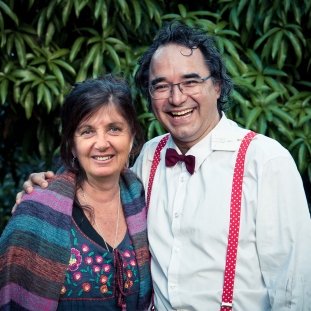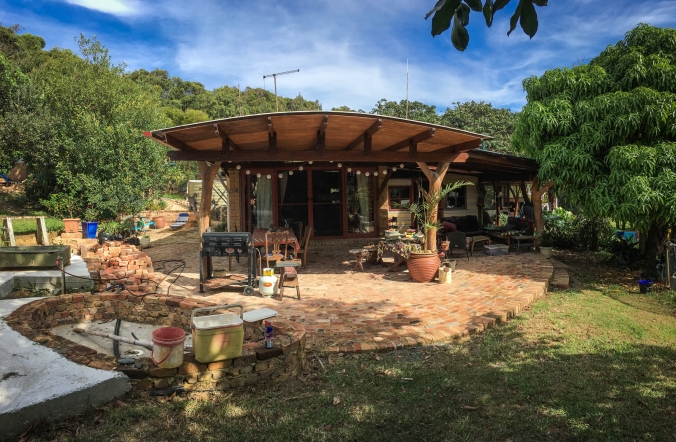Bundagen, NSW
Bundagen is an intentional community situated on the mid-north coast of NSW, just south of Coffs Harbour. It is a rural land sharing co-operative and wildlife sanctuary, guided by three main principles: social harmony, environmental responsibility and economic independence. It is bordered by Bongil Bongil National Park on all sides, including the headland and beach. It also includes world heritage rainforest. Yes, I admit, the stunning location was a bit of a draw card for us!
It took us about twenty minutes from the highway, winding through beautiful native forest and Bundagen’s tropical vegetation, to reach our hosts’ home in the The Bananas village. (No prizes for guessing what fruit tree once completely covered this area.) This village is the closest one to the beach (less than a ten minute walk) and at the end of a hard day of labour it was pretty lovely to be able to immerse ourselves in the waves or simply gaze at the ocean and often stormy sky – so restorative.
Bundagen began back in the early 1980s when local environmentalists became concerned about the possible purchase of two farms and bushland for tourist development, and the subsequent loss of valuable forest. A company was formed and individual loans called for in order to save the land. Eventually, enough money was raised and the land bought soon after. The company was then turned into a co-operative and those who had made the loans became the first shareholders.
Now, there are approximately 180 members, of whom about 110 live on site, with their children, in the twelve villages that make up Bundagen. The whole community is independent of mains water, sewerage and electricity. They rely on dams and rain-water tanks and use alternative technology, such as solar power and composting toilets.*
*Source: bundagen.org.au
Hosts of fun
 Our hosts, Giri and Jo, were great – providing some of the best conversations and laughs we’ve had in a while! Jo is a counselor and specialist in communication and parenting, whilst Giri practises humour therapy. Numerous evenings were spent around the kitchen table, drinking wine and discussing a whole range of topics from non-violent communication to clowning to spirituality. Giri would often softly strum his ukulele in the background and occasionally pull out one of his accordions for a more lively interlude of music! And the humour and jokes flowed freely. We really got along well.
Our hosts, Giri and Jo, were great – providing some of the best conversations and laughs we’ve had in a while! Jo is a counselor and specialist in communication and parenting, whilst Giri practises humour therapy. Numerous evenings were spent around the kitchen table, drinking wine and discussing a whole range of topics from non-violent communication to clowning to spirituality. Giri would often softly strum his ukulele in the background and occasionally pull out one of his accordions for a more lively interlude of music! And the humour and jokes flowed freely. We really got along well.
 During our stay, Mike and I were housed in a cosy 60s-styled caravan not far from the house. Using a “wee” bucket (not small, the other kind) behind a screen that we erected next to the caravan was a new experience for me, but I took it in my stride (quite literally) and I’m sure the citrus and banana trees were thankful for the extra nutrients. Otherwise, there was the compost toilet. Why do flushing loos exist, I found myself asking again. They’re such a silly, wasteful idea.
During our stay, Mike and I were housed in a cosy 60s-styled caravan not far from the house. Using a “wee” bucket (not small, the other kind) behind a screen that we erected next to the caravan was a new experience for me, but I took it in my stride (quite literally) and I’m sure the citrus and banana trees were thankful for the extra nutrients. Otherwise, there was the compost toilet. Why do flushing loos exist, I found myself asking again. They’re such a silly, wasteful idea.
Thoughtful design and natural beauty
Giri and Jo have a beautiful home, built with their own hands. It’s taken them couple of decades to add a kitchen, bathroom, verandah and outdoor living space to their initial one-room abode (just a tent in the early days), and the bedroom wing is yet to be built, but I sensed pride in the beauty they’ve created through the use of natural and recycled materials, and delayed satisfaction in waiting until they have the finances instead of going into debt.
They have also been mindful of making sure their home is accessible to people in a wheelchair or the elderly, whether it be themselves or others who live here in the future. They see their home as a place for many to enjoy, not just themselves. Their openness and hospitality is obvious with neighbours and friends dropping by each day (which I loved). Friendship and trust amongst neighbours are the norm. What a contrast from typical suburbia where disconnection and fear dominate our lives. Oh to live this way, where instead of yearning for human connection you may need to put up boundaries to occasionally get your work done!
I loved seeing some of the other homes in the village as well. Nestled amongst tropical vegetation, they were modest in size and non-obtrusive within the landscape. One was octagon and featured a loft, another had a series of rooms joined by covered walkways. Natural materials such as wood, stone, and rammed earth were primarily employed – a lovely extension of nature. On the outside, wide verandahs and decks were ideal places to gather in warm weather. On the inside, each home had loads of character and felt very inviting. These low-impact homes were some of the most beautiful and livable ones I’ve ever seen. And their organic gardens only added to the sense of working with nature, not against it.
One of our tasks during the first week was helping Giri build a fire wall made with recycled bricks and river stones. It was a good opportunity to learn some new techniques, such as “pointing” (I imagined I was working on a medieval castle!), as well as appreciate the labour-intensiveness of such a task. It was rewarding to see a beautiful, organic structure emerge at the end of the day and I think I am beginning to let go of the need for perfect symmetry. (I also think I’m a pretty good sorter, stacker and carter of bricks now!)
Striving for social harmony
During our time in Bundagen it was great to participate in a couple of community events such as a singalong at a neighbours’ house where no one cared if you didn’t have great pitch, and a Saturday morning working bee whereby about 20 of us donned gumboots, sloshed through mud and pulled out a weed on the banks of a dam. Following this, a lunch was provided at neighbour’s place for those who had participated. I love how a simple and not always pleasant task such as pulling weeds can be become light, enjoyable and even community building.
But often, real hardship is what brings people together, as most of us know. Bundagen has certainly had its share of pain and difficulties, including the tragic loss of young lives and court cases with disgruntled members wanting to sell their assigned piece of land (all land is owned by the cooperative and can’t be sold individually), the latter proving that unfortunately people can change over the years and lose sight of original shared values.
In the community, there is an ongoing issue with a member who has caused a huge amount of stress to others. Unfortunately, after many years of attempting to show compassion towards this person and work through conflict, nothing has changed. Still, members are rallying together, discussing what can be done, and where the boundaries need to be drawn for the sake of everyone’s well-being.
Living in intentional community isn’t any easier than living in mainstream society. People have to deal with the same politics and problems as in the wider community. But I do believe that the level of support, the willingness to work through issues and the potential to become better people in the process is greater.
Longevity
I think the fact that Bundagen has been going for 35 years and there’s practically a waiting list for people who want to join says a lot. It seems the community is still very committed to social harmony and being caretakers of the land, which is the “glue” that keeps them together and makes them attractive to others. “I feel so blessed to live here” and “We are really happy and regularly grateful” were a few expressions I heard.
House-sitting, when possible, is a great way potential new members as well as the community can get to know each other and see whether both parties are a good fit. And a lengthy and thorough joining process ensures that new members share the same philosophy as the group. All this contributes to the health and sustainability of Bundagen.
Final thoughts
I can see why people would want to live in Bundagen: for the natural beauty, the opportunity to live completely off-grid and tread lightly on the earth, and of course the friendship and support. However even after all these positives, I’m not sure it would be for me… I think I’m looking for something that feels even more close-knit and interdependant, with shared meals and activities happening almost daily. But who’s to say this isn’t happening in some of the villages – we really only saw a small piece of the whole.
Jump on Bundagen’s website if you’d like to know more, including the shared spaces and activities, decision making and membership.
And here’s Mike’s perspective on our time in Bundagen.




Pingback: Bundagen IC: serenity by the sea | Clever Creatures